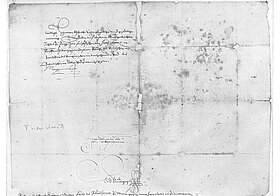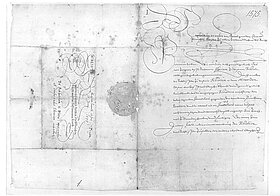In 1575, Emperor Maximilian II (1527–1576) appointed Hugo Blotius (1533–1608), a much-travelled Dutch scholar, the imperial library’s first official librarian. When he took office, the library was located in a room in the Minorite Monastery near the castle. His most important task was to draw an inventory of the holdings, so Blotius set up an index by authors. He also compiled a thematic Turcica catalogue listing works about the Turks, which was to shed light on the empire’s most dangerous enemy. At the beginning of Blotius’s term of office, the library comprised about 7,400 volumes manuscripts and rare books containing more than 20,000 (independent) works; by the time his term ended (in 1608), the holdings had grown to approximately 11,000 volumes.
In 1623 the imperial library moved from the Minorite Monastery to "Harrach House", a building belonging to the imperial castle (on today’s Ballhausplatz) that also accommodated the court’s accounting department. In these rooms, which were much better suited, the library would remain for more than 100 years, until it was moved to the newly erected library building on Josefsplatz.
The political function of the court library was subsequently underscored by imperial decrees on the delivery of mandatory copies. The imperial patent of 26 August 1624 issued by Ferdinand II stipulated the delivery of one copy of each and every printed book available at the Frankfurt spring and autumn fairs. Nevertheless, the library continued to see the largest growth of its holdings through the acquisition and relocation of larger libraries.
Due to a legally required works meeting, all user facilities of the Austrian National Library (reading rooms at Heldenplatz and collections) will not open until 11.30 a.m. on Thursday, 21 November, 2024.
Please note the opening hours during the holidays.



